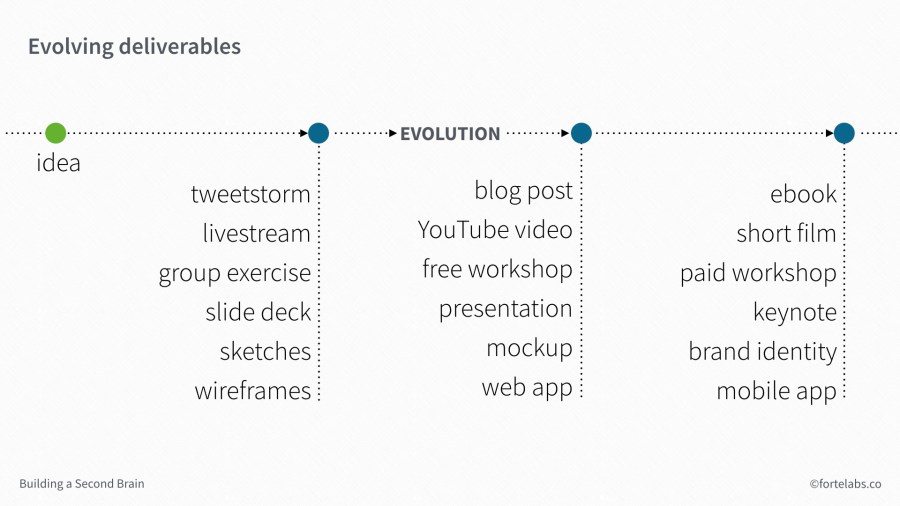
In Part 5, I introduced The Iron Triangle of Project Management and the idea that any given deliverable can be reduced or expanded in scope at any time.
How should you use this newfound ability? You should use it to:
- Get started
- Maintain momentum
- Test assumptions
1. GET STARTED
When considering starting new projects, we often think of them as being fixed in scope: a website with a precise list of features, a report at a certain level of specificity and polish, or a full-sized book with a certain number of pages.
But if you force one side of the Triangle to be static, the other two sides blow out. You may have noticed that most people are waiting until they have a lot of time, and/or a lot of money before starting. You may have heard people say that “It just takes as long as it takes.” But that’s only true if the definition of “it” is not subject to change.
By downscoping the project you have in mind, you can lower the bar until it takes just one step to get over it. Once that first experiment is finished, you can build on it with larger projects.
2. MAINTAIN MOMENTUM
Sometimes we begin a new project with a bang, but then “life” gets in the way. A child gets sick, the roof starts leaking, work gets crazy, etc.
By thinking of a given deliverable not as a fixed object, but as a continuum – from an ideation or conception stage to a draft or prototype stage all the way to a polished final product – we gain the ability to modulate our progress depending on how much is going on elsewhere.
Downscope the current part of the project you’re working on and make progress in smaller chunks when things get busy, and upscope it when you have more time and want to move faster.
3. TEST ASSUMPTIONS
As your project evolves, there is a lot of learning that needs to happen for you to discover exactly what the final product should be. These learnings often take the form of questions to be answered, assumptions to be tested, or hypotheses to be proven or disproven.
The process of developing a new project, product, or service is littered with unknowns at every stage. It is therefore primarily a learning process, as you discover how your solution fits your audience’s existing needs.
By adjusting the scope of your deliverables, you can design them specifically to test certain assumptions. For example, if you want to make an Onboarding Manual for your team, you could start by making a proposed outline of the main sections and getting feedback from the latest hires. Instead of launching into production with a heavy lift, this smaller deliverable can remove a lot of uncertainty with a fraction of the effort.
The point is, there is always a smaller and simpler version of whatever it is you’re seeking to create. Here are some examples:
Do you want to write an ebook? Start by summarizing what you have to say in a blog post. Not sure where to start? Begin with a 5-minute tweetstorm.
Do you want to make a documentary or short film? Start with a 5-10 minute YouTube video. Is recording something intimidating? Then begin with a Facebook Live or Periscope livestream.
Do you want to offer a paid workshop? Start with a free one delivered to your colleagues or friends. If that’s too much, begin with a 30-minute exercise with your team at work.
Do you want to deliver a keynote at a conference? Start by recording your presentation in front of a camera. If that’s too scary, start by making your slide deck and showing it to someone.
Do you want to get hired to design a brand identity for a company? Start by creating a mockup of a homepage. Don’t have time for that? Make some simple sketches on a notepad for practice.
Do you want to launch a mobile app? Start with a web app, which is simpler and faster to build. Don’t quite have the skills required? Make some wireframes in a mindmapping tool showing how the app will work.
Compounding gains
As you start to downscope your deliverables, you’ll find that these smaller packets fit into many more pockets of time throughout your day. Instead of requiring hours to get anything of value done, you’ll begin to make little spurts of progress anytime you have even 5 or 10 minutes.
As you make small bits of progress more often, you’ll notice that you don’t have to spend as much time “getting up to speed.” Since you’re never trying to load the entire project into your mind at once, only the parts that relate to the small deliverable you’re working on in the current session.
Soon you’ll notice that you don’t have to spend virtually any time getting up to speed, because you’re so good at documenting your work that you’re able to “freeze” any project in mid-flight. You start to notice that nothing can derail you, because you can fit progress into any available space in your schedule. You make every minute count, so every minute is valuable.
Rescoping your deliverables is a skill, not just a tool. It requires self-awareness and intuition, to sense the interplay between constraints and trust your intuition to tell you which one needs adjusting.
All work exists on a continuum, from incipient idea to polished product. There is a lot of power in seeing everything you’re working on as a particular stage of evolution, which can be accelerated or slowed down as conditions change.
Follow us for updates on Twitter, Facebook, Instagram, LinkedIn, or YouTube.
The Only Subscription
You Need to
Stay at the
Edge of AI
The essential toolkit for those shaping the future
"This might be the best value you
can get from an AI subscription."
- Jay S.
Join 100,000+ leaders, builders, and innovators

Email address
Already have an account? Sign in
What is included in a subscription?
Daily insights from AI pioneers + early access to powerful AI tools








Comments
Don't have an account? Sign up!